David's Astronomy Pages (Projects)
|
Nearby Stars |
Projects Page |
Home Page |
Star Clusters |
|

Selected Extrasolar Planet Sols This page summarises images and observations of selected stars that are known to have extrasolar planets that are detectable as small brightness decreases during transit of the planet across the host sol. HD 149026 HD 189733 HD 209458 (Osiris) HAT-P-1 (ADS 16402 AB) HAT-P-2 (HD 147506) HAT-P-3 (GSC 3466:819) HAT-P-5 (GSC 2634:1087) TrES-1 (GSC 2652:1324) TrES-2 (GSC 3549:2811) TrES-3 (GSC 3089:929) TrES-4 (GSC 2620:648) WASP-1 (GSC 2265:107) WASP-2 (GSC 522:1199) XO-1 (GSC 2041:1657) XO-2 
Future Project Stars
- -
Web Resources
SolStation -
Notable nearby stars [http://www.solstation.com/stars.htm
TransitSearch.Org TransitSearch.org
{ Check for Transits }
The Extrasolar Planets Encyclopaedia [http://exoplanet.eu ]
Summary Table of parameters for transiting planets [ http://www.inscience.ch/transits/ ]
Back to Top
| HD 149026 (Hercules) |
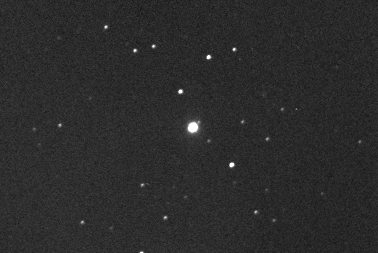
|
|
Annotated
CCD Image 3 x 30s (average combine), C filter) 2006-07-23 22:50h UT (#131053-55) |
| Monitoring HD 149026 for small magnitude
changes during exosolar planet transits will be difficult due to the lack of a suitable reference star of similar brightness within the same field of view. Less accurate method of monitoring will be to alternate frames of HD 149026 with frames from offset reference star. |
| Possible offset stars : |
| HIP 80885 (Hercules) HIP 80885 is actually a double star (Struve 2059) with 1 arc sec separation (too small to be seen at resolution of image) |
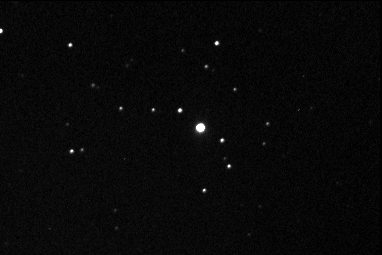
|
|
CCD Image 3 x 15s (average combine), C filter) 2006-07-23 23:14h UT (#131092-94) |
Back to Top
|
HD 189733 (Vulpecula) |
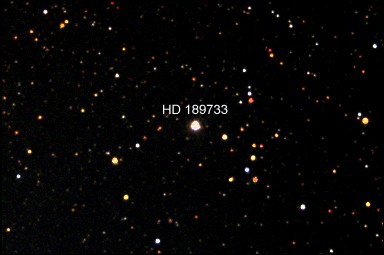 |
| Approximate Colour CCD Image Luminance : 3 x 30s (median combine, C Filter), Red : 3 x 30s (medium combine, R filter), Green : 3 x 30s (medium combine, V filter), Blue : 3 x 60s (medium combine, B filter) 2006-04-27 02:46h UT (#117200-11) |
| HD 189733 - B Band |
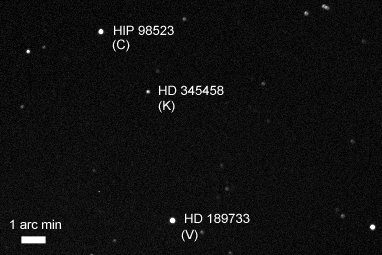 |
| Annotated CCD Image 20 sec exposure, 2x2 binning, B Filter 2006-04-28 00:22 h UT (#118196) |
| HD 189733 - V Band |
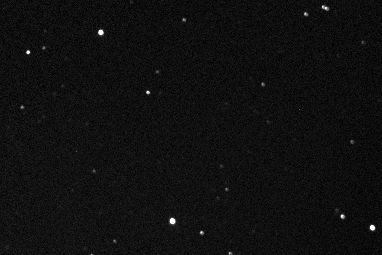 |
| CCD Image 10 sec exposure, 2x2 binning, V Filter 2006-04-28 00:22 h UT (#118197) |
|
Tests suggest imaging at 60s (B) and 30s
(V) to improve S/N |
Back to Top
| HD 209458 (Pegasus) Alt Names : Osiris, GCVS V0376 Peg, SAO 107623, HIP 108859 |
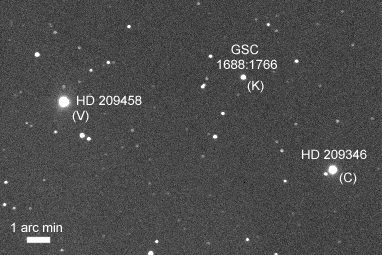
|
|
CCD Image 60s (C filter) 2006-07-18 01:09 hUT (#130108) |
| Example V Filter image of HD 209458 HD 209458 (V), HD 209346 (C), GSC 1688:1766 (K) |
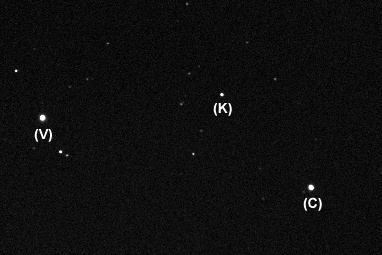
|
|
Annotated CCD Image 15 sec exposure (V filter) 2005-08-05 22:30h UT(#91090) |
| Other Images : 2002-10-02 / 2004-08-20 / 2005-08-05 |
Transit Detection Attempt, 2005-08-08
- 4h 20m session attempting to record the transit of extra solar
planet HD 209458b across its sol HD 209458 (Osiris)
- 552 images were recorded over a period of 3h 50m (15 sec exposures
through V filter)
- Inconsistent sky conditions and deteriorating sky conditions with cloud after
01:00 h UT reduced data quality.
- A description of the attempt
and results has been compiled.
- Analysis suggests an overall dimming of ~ 0.01 mag during the time of the
transit, but this is unfortunately within the
uncertainty range of the measurement (typically +/- 0.01 to +/- 0.02 mag).
Detection of the dimming event was also compromised by having insufficient data
prior to ingress and deteriorating sky conditions around the time of
egress.
| Graph showing differential magnitudes
for HD 209458 (Corrected for B-V colour difference between HD 209458 and Comparison Star) |
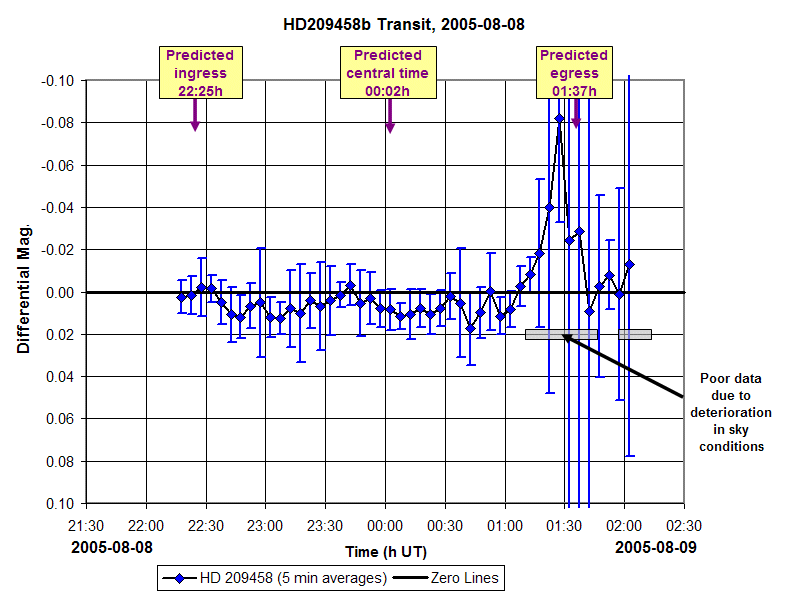
|
| Graphs shows points representing the
average differential magnitude in each 5 min period. High/Low lines are plotted at +/- 1 S.D. Data may possibly shows an overall dimming of ~ 0.01 mag during the time of the transit, but this is unfortunately within the uncertainty range of the measurement (typically +/- 0.01 to +/- 0.02 mag). Detection of dimming is also compromised by having insufficient data prior to ingress and deteriorating sky conditions with cloud around the time of egress. |
Back to Top
| ADS 16402 (Lacerta) |
|
Using small automated telescopes in Arizona
and Hawaii, the HATNet project has detected an |
|
|
|
ADS 16402 (Lacerta) |
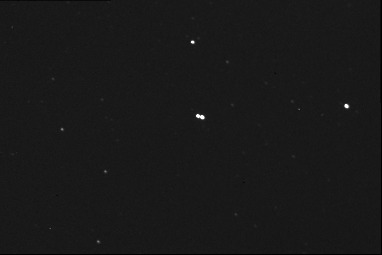
|
|
CCD Image 5 x 30s exposure (average combine), 2x2 binning, C Filter 2006-10-22 19:26h UT (#148054-58) |
| BBC
Report Science Paper |
Back to Top
|
HAT-P-2 / HD 147506 (Hercules) |
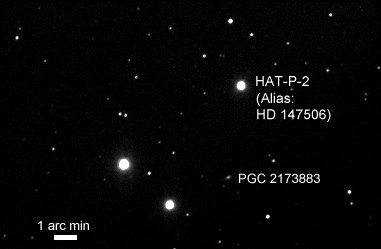 |
|
Annotated CCD Image 3 x 60s (average combine), 2x2 binning, C Filter 2007-05-07 23:23 hUT (#196053-61) |
| HAT-P-2, Reference Stars |
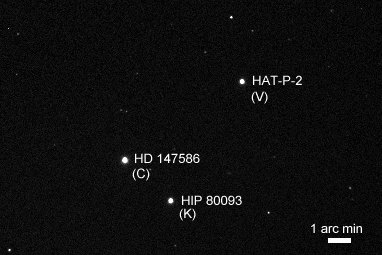 |
| Annotated CCD Image 20s, 2x2 binning, R Filter 2007-05-07 23:31 hUT (#196065) |
Back to Top
Baseline images of HAT-P-3 parent star (GSC 3466:819) were acquired as part of a a future project to attempt to detect the transit of an exosolar planet using my 8" LX200 scope. HAT-P-3 was only recently discovered (Torres et al, 2007, http://exoplanet.eu/papers/torres_2007.pdf ). It rotates around its host star in ~ 2.9 days, and has a reported transit time of 2.06 hours.
| HAT-P-3 Parent Star / GSC 3466:819 (Ursa Major) |
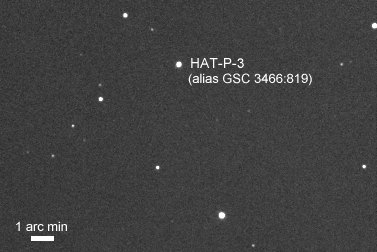
|
|
Annotated CCD Image 3 x 30 sec exposure (median combine), 2x2 binning, C Filter 2007-08-13 22:25h UT (#204079-87) |
| Reference Stars |
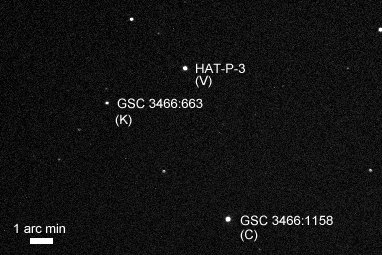
|
|
Annotated CCD Image 60 sec exposure, 2x2 binning, R Filter 2007-08-08 13 22:32h UT (#204091) |
Back to Top
Baseline images of HAT-P-5 parent star (GSC 2634:1087) were acquired as part of a a future project to attempt to detect the transit of an exosolar planet using my 8" LX200 scope. HAT-P-5 was only recently discovered (reference) . It rotates around its host star in ~ x,x days, and has a reported transit time of x.xx hours.
| HAT-P-5 Parent Star / GSC GSC 2634:1087 (Lyra) |
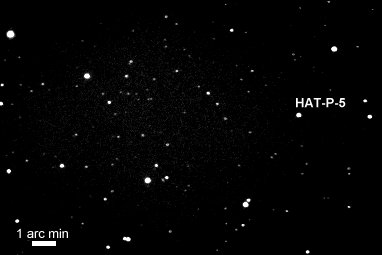
|
|
Annotated CCD Image 3 x 60 sec exposure (average combine), 2x2 binning, C Filter 2008-06-08 23:36h UT (#290040-44) |
| HAT-P-5 - Reference Stars |
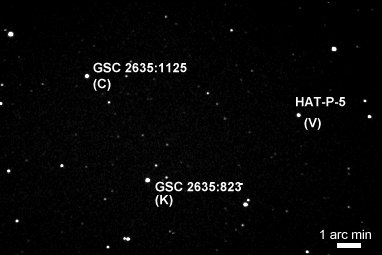
|
|
Annotated CCD Image 2 x 60 sec exposure (average combine), 2x2 binning, R Filter 2008-06-08 23:42h UT (#290040-44) |
Back to Top
| TrES-1 Parent Star / GSC 2652:1324 (Lyra) ~ 500 light years, distance Planet orbit 3.03 days |
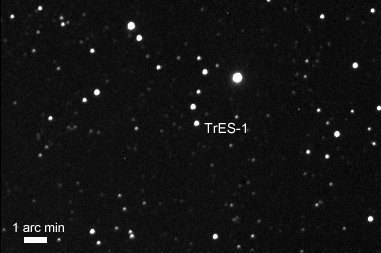
|
|
Annotated CCD Image 3 x 20s (average combine), C filter) 2006-07-23 23:32h UT (#131124-26) |
| Note : Discrepancy seen with GSC 2652:1291
(V Band) mag. Catalog +11.2, Measured Estimate +10.3. Recommend monitoring for variability |
Back to Top
| TrES-2 Parent Star / GSC 3549:2811 (Draco) < 750 light years, distance Planet orbit 2.47063 days V Magnitude: +11.4 , Spectral Type: G0V ] |
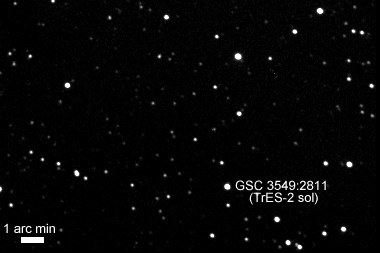
|
|
CCD Image 3 x 60 sec exposure (average combine), 2x2 binning, C Filter 2006-11-26 19:30h UT (#155074-82) |
| Colour Images |
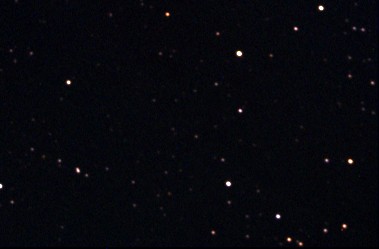
|
|
Approximate Colour CCD Image BVR, 2x2 binning Red 3x60s (R Filter), Green 3x60s (V Filter), Blue 3x120s (B Filter) 2006-11-26 19:30h UT (#155075-85) |
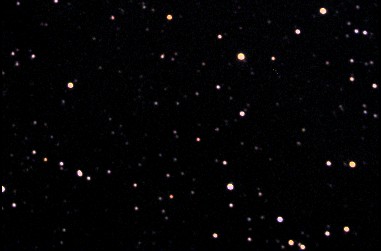
|
|
Approximate Colour CCD Image CBVR, 2x2 binning Luminance : 3 x 60s (C Filter), Red 3x60s (R Filter), Green 3x60s (V Filter), Blue 3x120s (B Filter) 2006-11-26 19:30h UT (#155075-85) |
| Reference Stars |
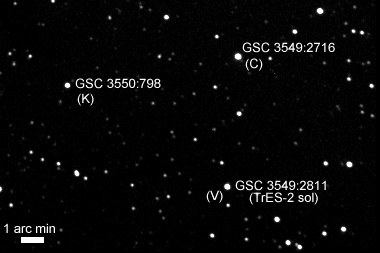
|
|
CCD Image 3 x 60 sec exposure (average combine), 2x2 binning, C Filter 2006-11-26 19:30h UT (#155074-82) |
Back to Top
Baseline images of TrES-3 parent star (GSC 3089:929 ) were acquired as part of a project to attempt to detect the transit of an exosolar planet using my 8" LX200 scope. TrES-3b was recently discussed to orbit this star. (TrES team, 2007, http://xxx.lanl.gov/PS_cache/arxiv/pdf/0705/0705.2004v1.pdf )
| TrES-3 Parent Star / GSC 3089:929 (Hercules) |
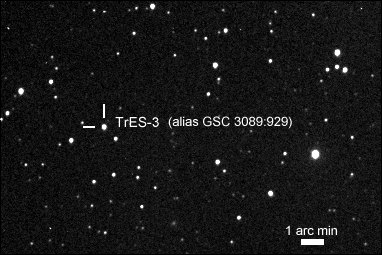
|
|
Annotated CCD Image 3 x 60 sec exposure (average combine), 2x2 binning, C Filter 2007-08-13 23:02h UT (#203194-98) |
| Reference Stars |
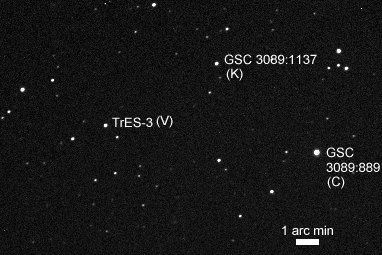
|
|
Annotated CCD Image 60 sec exposure, 2x2 binning, R Filter 2007-08-13 23:07h UT (#204124) |
Back to Top
Baseline images of TrES-4 parent star (GSC 2620:648) were acquired as part of a project to detect the transit of the exosolar planet, that has recently been discussed to orbit this star . [ BBC news article]
| TrES-4 Parent Star / GSC 2620:648 (Hercules) |
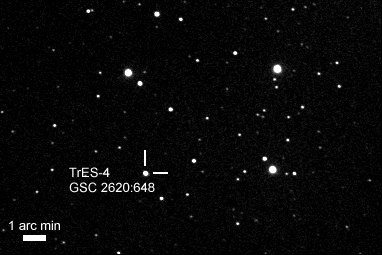
|
|
Annotated CCD Image 3 x 60 sec exposure (average combine), 2x2 binning, C Filter 2007-08-08 01:09h UT (#203194-98) |
| Reference Stars |
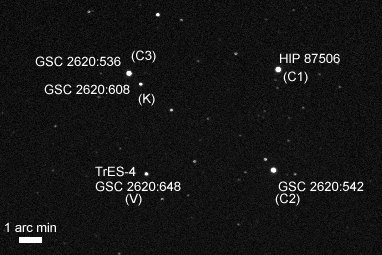
|
|
Annotated CCD Image 30 sec exposure, 2x2 binning, R Filter 2007-08-08 01:09h UT (#203195) |
Back to Top
Baseline images of WASP-1 parent star (GSC 2265:107) as part of a project to attempt to detect the transit of an exosolar planet using my 8" LX200 scope. [WASP-1 paper : http://www.blackwell-synergy.com/doi/abs/10.1111/j.1365-2966.2007.11976.x ]
| WASP-1 (GSC 2265:107) (Andromeda) |
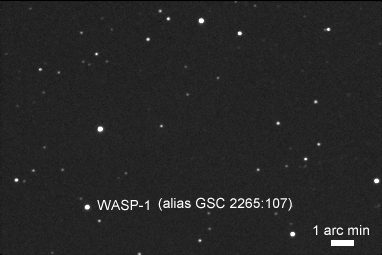
|
|
Annotated CCD Image 3 x 30 sec exposure (median combine), 2x2 binning, C Filter 2007-08-14 00:24h UT (#204224-28) |
| WASP-1 (GSC 2265:107) (Andromeda) |
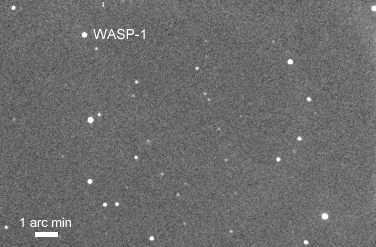
|
|
Annotated CCD Image 3 x 45 sec exposure (median combine), 2x2 binning, C Filter 2007-08-18 00:20h UT (#205011-15) |
| Reference Stars |
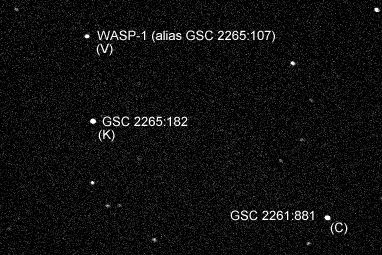
|
|
Annotated CCD Image 60 sec exposure, 2x2 binning, R Filter 2007-08-18 00:24h UT (#205017) |
Back to Top
Baseline images of WASP-2 parent star (GSC 522:1199) were acquired as part of a project to attempt to detect the transit of an exosolar planet using my 8" LX200 scope. WASP-2b was recently discussed to orbit this star.
| WASP-2 (GSC 522:1199) (Delphinus) |
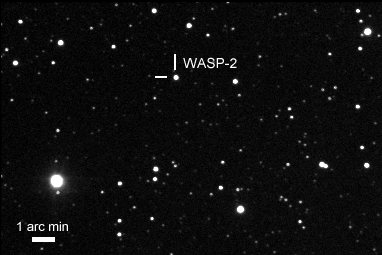
|
|
Annotated CCD Image 3 x 60 sec exposure (median combine), 2x2 binning, C Filter 2007-08-14 00:32h UT (#203232-36) |
| Reference Stars |
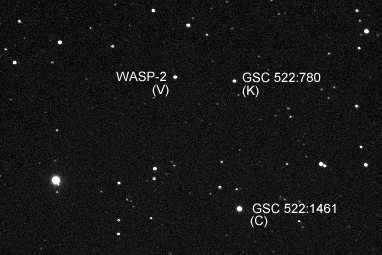
|
|
Annotated CCD Image 45 sec exposure, 2x2 binning, R Filter 2007-08-14 00:30h UT (#204233) |
Back to Top
Web Info : XO-1 - McCollough et al. paper
|
XO-1 (Corona Borealis) |
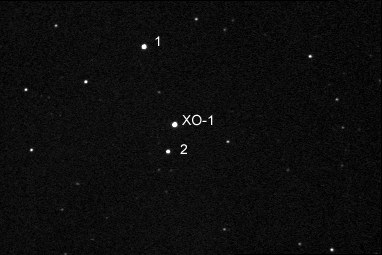 |
| Annotated CCD Image 3 x 30s exposure (average combine), 2x2 binning, C Filter 2006-05-24 23:18 hUT (#127028-30) |
|
|
Back to Top
|
XO-2 / GSC 3413:5 (Lynx) |
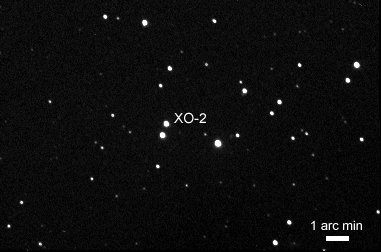 |
|
Annotated CCD Image 3 x 60s (average combine), 2x2 binning, C Filter 2007-05-07 22:56 hUT (#196028-30) |
| XO-2, Reference Stars |
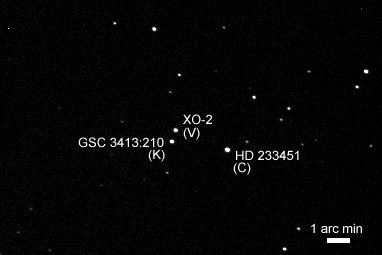 |
| Annotated CCD Image 30s, 2x2 binning, R Filter 2007-05-07 23:07 hUT (#196040) |
Back to Top
Potential Future Project Stars
CoRoT-Exo-1 (Host Star . http://exoplanet.eu/papers/PR-CoRoT-1.pdf
GJ 436, Leo
HAT-P-5 (2634:1087) - http://www.perseus.gr/Astro-Photometry-HAT-P-5-20080528.htm
: Monitor TransitSearch.org for new or potential transiting planets.
Web Information on notable nearby stars : http://www.solstation.com/stars.htm
Back to Top
| This Web Page: | Extrasolar Planet Stars (Projects) |
| Last Updated : | 2015-05-16 |
| Site Owner : | David Richards |
| Home Page : | David's Astronomy Web Site |